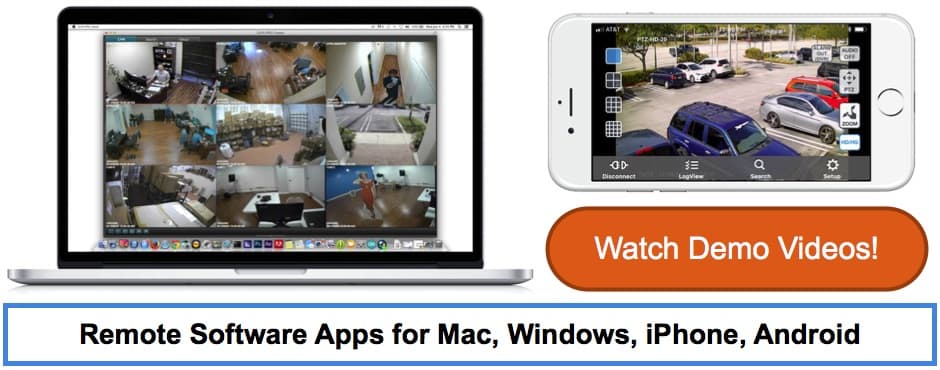DVR Viewer Software Setup for Network / Remote Internet Camera View
This page has instructions on how to setup the remote security camera / DVR viewer software for JPEG2000 DVRs. CCTV Camera Pros use to supply the dual codec JPEG2000 DVR, however, those JPEGs DVRs has been replaced by the latest Viewtron CCTV / HD security camera DVR which works with analog CCTV cameras, HD-over-Coax security cameras, 4K BNC security cameras, and network IP cameras. You can still use the JPEG2000 DVR viewer setup instructions here.
Viewtron DVRs include the best remote camera viewing apps for iPhone, Android, Mac, and Windows. The mobile apps and software also with this IP camera NVR with PoE.
Remote Security Camera View from iPhone, Android, Mac & Windows Apps
iPhone App

|
Android App
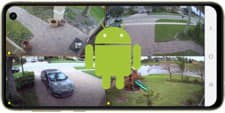
|
Mac Software
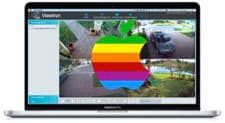
|
Windows CMS Software
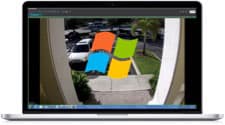
|
The DVR software that was included with JPEG DVRs is called the integrated remote station (IRS). One of the applications in the IRS is a transmitter that allows you to watch your security cameras over the Internet or Intranet (internal network / LAN). The transmitter is meant to replace the DVR viewer that was used in the last version of the JPEG DVR.
The integrated remote station also lets you review previously recorded surveillance video footage. The last version of the DVR viewer integrated remote station that was released can be downloaded here:
Integrated Remote Station. The integrated remote station, also referred to as the DVR viewer software, runs on a Microsoft Windows based computer.
Please follow these setup instructions to setup remote Internet access for the dual codec JPEG DVR:
-
-
-
-
-
-
-
-
In this section, we will assign your surveillance DVR an IP address. Make sure that your DVR is connected to your network by attaching an ethernet cable to the back of your DVR and attaching the other end to your router.
- Login to your DVR by pressing the menu button on the DVR or on the wireless remote control.
- When you are prompt to enter a password, just press the OK button on the DVR or remote. The default admin password for the DVR is blank. If you have already setup an admin password for your DVR, then enter this, then press OK.
-
From your DVRs System menu, select External Device.
-
On the External Device menu, select TCP/IP Setup.
-
On the TCP/IP Setup screen, select DHCP setup and press enter.
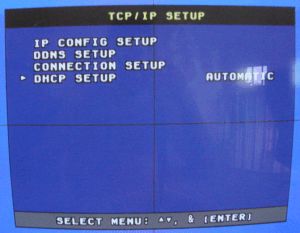
-
On the DHCP setup screen, confirm that the DHCP mode is set to automatic. If it is not, adjust it so that it is by pressing the OK button.
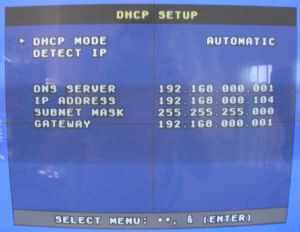
-
Select Detect IP and press enter. The screen should refresh and populate values below. Note the IP address. This is the internal IP address that your router has assigned to your DVR. This is the IP address that you will setup port forwarding for.
-
After you have noted this IP address, select DHCP Mode and press OK. The mode will be changed Manual. This will ensure that your DVR will always be assigned the same IP address from your router. THIS IS IMPORTANT because if you loose power to your router, your router may assign your DVR a difference IP address and you will no longer be able to access the DVR remotely.
-
Press the menu button once to return to the TCP/IP setup screen.
-
On the TCP/IP setup screen, select IP config setup and press enter. On the IP config setup screen, confirm the port number of your DVR as seen below. The default port is 8000. If your DVR is not set to port 8000, please edit this value to set to 8000. NOTE: please ignore that the below screen shot shows port 50000. Port 50000 was used for the last version of the JPEG DVR.
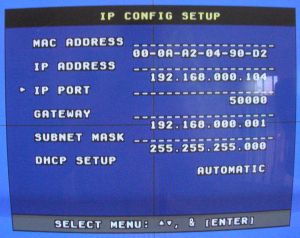
- Press the Menu several times on your DVR or remote until you exit out of the DVR menu system and see the live view of your cameras.
The Integrated Remote Station allows you to access your security cameras locally on your netork as well as remotely over the Internet. Before proceeding with remote Internet access, it is a good idea to test out local access first. Also if you do plan on using the DVR viewer / Integrated Remote Station from on the same network as your DVR, you will get much better performance using your network's local IP address
-
Install the most recent version of the Integrated Remote Station by downloading it from our website here: Integrated Remote Station Download. This version is always the most recent and should be used instead of the version that is on the CD that came with your DVR.
-
Save the file "JPEG-IRS-Setup.exe" to your windows desktop or select run. This is the installation file to install the Remote Station on your computer. If you saved the file, locate it and double click on it to begin installation. If you selected to run the program, the installation will begin after the file is done downloading.
-
Once the installation is complete, an icon will be created on your Windows desktop to launch the Integrated Remote Station. The icon will look like this:

-
Double-click on the icon to launch the program.
-
On the main IRS screen, click on the IRS Setup button.

-
On the IRS Setup screen, click on the Registering Site button. This will open a new Window where you can add the settings to connect to your DVR. This screen can be seen below. 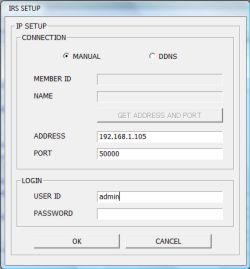 A) Select Manul for CONNECTION. B) Enter the IP address that you previously noted from your DVR's TCP/IP setup screen in the ADDRESS field. IMPORTANT: If any of the number fields in the IP address contain leading zeros, they should be removed. For example, if your DVR's IP address is 192.168.000.066, you should enter 192.168.0.66. C) Enter 8000 for PORT D) Enter admin for USER ID E) Leave the password blank if you did not setup a password on your DVR or enter your DVR password if you did set one up. Press OK when done.
-
You should now see an entry created for the local area connection (Intranet) information that you just entered in the Site Setup list on the IRS Setup screen. Click on the entry that you just created so that it is highlighted in green then press OK.
-
On the main Integrated Remote Station screen click on the Transmitter button. This will open the DVR transmitter which is that new DVR viewer application. You can note that also in this list there are other application. Although this application replaces the DVR Viewer, you can see there is still a Viewer application available. This is so that older legacy DVRs can still use the IRS application by using the DVR Viewer. Remember for the dual codec DVRs you should use the Transmitter because you will get better performance as it takes advantage of the H.264 MPEG-4 video encoding built into it.
-
Once the transmitter application opens, the connection information that you setup will be populated in the upper right. Click on the Connect button. The transmitter should fairly quickly connect to your DVR and display your security cameras.
-
-
Port forwarding needs to be setup on your router so that a computer on the Internet can communicate remotely with your surveillance DVR. Click here if you want to learn more about how port forwarding works. Follow the below instructions to setup port forwarding.
Remember: Your DVR is going to use port 8000 (not 50000). 50000 was the default port for legacy non-dual codec DVRs).
If you do not have one of the routers listed below, please consult the manual for the router that you have or call your Internet Service Provider (ISP) for help if you are using a modem / router supplied by them. Tell them that you need to open and forward port 8000 to a DVR on your network.
Although you previously setup the DVR to always request the same IP address from your router when when you set the DHCP setting to manual in the DVR configuration, it is still a good idea to also configure your router to always assigns the same IP address to your DVR. Some routers support this feature and some do not. If your does not, it is OK to skip this section. The reason to set this up if you can is that if your router needs to be restarted or if there is a power failure, there is risk that your DVR will be assigned a new IP address. This will make the port forwarding setup that you just finished useless. Follow these instructions to setup a static IP address for your DVR.
These last three sections are needed to setup the remote Internet access to your security cameras. The first thing that should be done to setup remote access is to find out if your Internet connection has a static or dynamic IP address. If you do not know, please contact your Internet provider and ask them. If you have a static IP address, you can skip the next two sections and jump to setting up the Internet connection to your surveillance DVR.
If your DVR will be connected to the Internet using a dynamic IP address (most cable and DSL connections), you need to setup a free service to manage the DNS (domain name service) for you so that you can access your DVR remotely without needing to keep track of your IP address. If you are unsure whether your Internet connection uses a static or dynamic IP address, please contact your Internet service provider. If you are using a static IP address, you can skip this section and the next section "Setup Dynamic DNS on your Router". If you are using a dynamic IP address, click here to setup your free dynamic DNS service. Return to this screen to continue after setting up your free dynamic DNS service.
Dynamic DNS is used when the Internet connection you will be using for your DVR uses a dynamic IP address. The settings that you setup using the DynDNS service will be added to your router's DDNS configuration to always keep your IP address up to date. The host name that you chose, something like "mydvr.dyndns.org", will always be kept up to date with the latest IP address assigned to your Internet connection by your ISP. This way you can use your host name to connect to your DVR remotely instead of trying to keep track of your dynamic IP address. CCTV Camera Pros has DDNS setup instructions for D-Link and LinkSys routers. The instructions are based on certain models but are likely the same or close to the same for other models of D-Link and LinkSys routers. If you need specific instructions for you router, please consult the manual that came with it and look under the section that has to do with Dynamic DNS support. Most modern router/switches support dynamic DNS.
The last step is to configure the Internet connection in the Integrated Remote Station for access from outside of your local network.
-
If the IRS is not already running, please start it by double-clicking on the JM-IRS icon on your desktop:

-
One the main IRS screen, click on the IRS Setup button.

We will be adding a new entry for your remote Internet connection. So when you are finished, if you also setup the LAN connection, you will have two connection configured in the IRS setup. One for local access to your DVR and one for remote Internet access.
-
On the IRS Setup screen, click on the Registering Site button. This will open a new Window where you can add the settings to connect to your DVR. This screen can be seen below.

A) Select Manul for CONNECTION.
B) In the Address field, enter the static IP address that your ISP gave you if you are using a static IP address. If you are using a dynamic IP address and finished setting up your DynDNS account, please enter the host name that you setup when registering.
C) Enter 8000 for PORT
D) Enter admin for USER ID
E) Leave the password blank if you did not setup a password on your DVR or enter your DVR password if you did set one up.
Press OK when done.
-
You should now see an entry created for the Internet connection information that you just entered in the Site Setup list on the IRS Setup screen. Click on the Internet entry that you just created so that it is highlighted in green then press OK.
-
On the main Integrated Remote Station screen click on the Transmitter button. This will open the DVR transmitter which is that new DVR viewer application. You can note that also in this list there are other application. Although this application replaces the DVR Viewer, you can see there is still a Viewer application available. This is so that older legacy DVRs can still use the IRS application by using the DVR Viewer. Remember for the dual codec DVRs you should use the Transmitter because you will get better performance as it takes advantage of the H.264 MPEG-4 video encoding built into it.
-
Once the transmitter application opens, the connection information that you setup will be populated in the upper right. Click on the Connect button. The transmitter should fairly quicky connect to your DVR and display your security cameras.
DVR Viewer / Transmitter Troubleshooting Techniques
-
-
Make sure that you have the correct IP address for your Internet connection. Ask your ISP for your IP address if using a static IP address. You can also look up the IP address of your internet connection here:
Get My IP Address
-
Make sure that your router does not have any advanced firewall rules in place by consulting the manual.
-
Call your ISP and ask them if your modem has a firewall that you can disable.
-
Call your ISP and make sure that they do not block any incoming ports to your Internet connection.
Recommended Camera Viewing Apps and Software
You may be interested in in these mobile apps and desktop PC software that support remote security camera viewing.
Related CCTV and Surveillance System Products
These are some of CCTV Camera Pros best selling products.
|










